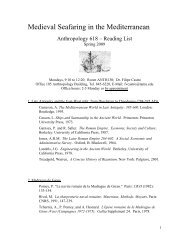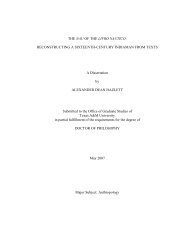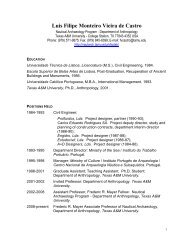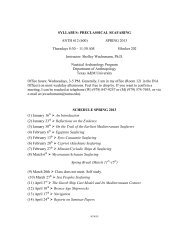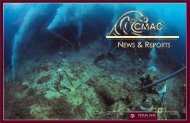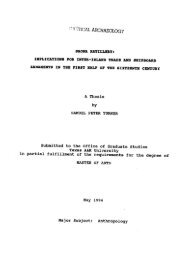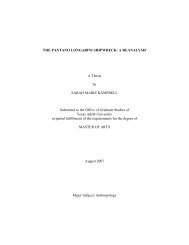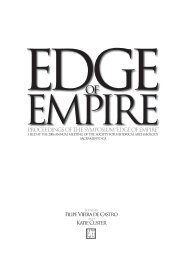Download Pdf of Dissertation - Nautical Archaeology at Texas A&M ...
Download Pdf of Dissertation - Nautical Archaeology at Texas A&M ...
Download Pdf of Dissertation - Nautical Archaeology at Texas A&M ...
Create successful ePaper yourself
Turn your PDF publications into a flip-book with our unique Google optimized e-Paper software.
vehementissumum sidus. Et VIII kal. Octobres aequinoctialis evenit acerba tempestas,<br />
circa nonas vero Octobres aeduli pluviales, V idus easdem Taurus. A ovembri autem<br />
mense crebris tempest<strong>at</strong>ibus navigia conturb<strong>at</strong> Vergiliarum hiemalis occasus. Ex die<br />
igitur tertio idus ovembres usque in diem sextum idus Martias maria clauduntur. am<br />
lux minima noxque prolixa, nubium densitas, aeris obscuritas, ventorum imbri vel nivibus<br />
gemin<strong>at</strong>a saevitia non solum classes a pelago sed etiam commeantes a terrestri itinere<br />
deturb<strong>at</strong>. Post n<strong>at</strong>alem vero, ut ita dicam, navig<strong>at</strong>ionis, qui sollemni certamine<br />
publicoque spectaculo multarum urbium celebr<strong>at</strong>ur, plurimorum siderum ipsiusque<br />
temporis r<strong>at</strong>ione usque in idus Maias periculose maria temptantur, non quo negoti<strong>at</strong>orum<br />
cesset industria, sed quia maior adhibenda cautela est, quando exercitus navig<strong>at</strong> cum<br />
liburnis, quam cum priv<strong>at</strong>orum mercium festin<strong>at</strong> audacia.<br />
In wh<strong>at</strong> months it is safer to be <strong>at</strong> sea. The analysis <strong>of</strong> the months and days follows.<br />
The roughness <strong>of</strong> the sea does not allow to sail for the entire year. Some months are the<br />
most favorable, others are dangerous, the remaining ones are too dangerous for the ships<br />
due to the laws <strong>of</strong> n<strong>at</strong>ure.<br />
Past Pachnitae –in other words after the constell<strong>at</strong>ion <strong>of</strong> the Pleiads has risen- from<br />
May 27 until the rise <strong>of</strong> Arcturus –in other words September 14– it is safe to be <strong>at</strong> sea,<br />
because the strength <strong>of</strong> the winds is mitig<strong>at</strong>ed by the grace <strong>of</strong> the summer.<br />
After this time and until November 10 it is not safe to be <strong>at</strong> sea. The length <strong>of</strong> the<br />
day is shorter because after September 13 Arcturus rises, baleful star, and on September 24<br />
the unpleasant equinoctial season begins. Around October 7 the winds carriers <strong>of</strong> rain<br />
come, and on the 15 th day <strong>of</strong> the same month the constell<strong>at</strong>ion <strong>of</strong> Taurus rises.<br />
During the month <strong>of</strong> November, on the other hand, the winter disappearance <strong>of</strong> the<br />
Pleiads causes trouble to the ships because <strong>of</strong> the heavy rain. Therefore, from November<br />
10 until March 10 the sea is unaccessible. The short daylight, the length <strong>of</strong> the night, the<br />
thickness <strong>of</strong> the clouds, the darkness <strong>of</strong> the air, and the strength <strong>of</strong> the winds twice as<br />
destructive due to the rain and to the snow, not only keeps the ships away from the sea, but<br />
also the travelers from a terrestrial trip.<br />
After the day -so to speak- navig<strong>at</strong>ion was born, th<strong>at</strong> is celebr<strong>at</strong>ed in several cities<br />
according to the position <strong>of</strong> the stars and time <strong>of</strong> the year with public games and races,<br />
until May 15, the sea can be sailed <strong>at</strong> the sailors’ own risk. It is not necessary to stop the<br />
trade <strong>of</strong> merchandises, but, since the fleet uses liburnian ships, it is necessary to be more<br />
careful than priv<strong>at</strong>e merchants usually are. (L. Campana).<br />
Verg. Aen. 3.551-3: Hinc sinus Herculei (si vera est fama) Tarenti / cernitur; <strong>at</strong>tolit se<br />
diva Lacinia contra, / Caulonisque arces et navifragium Scylaceum.<br />
Next is descried the bay <strong>of</strong> Tarentum, a town <strong>of</strong> Hercules, if the tale be true; while<br />
over against it rise the Lacinian goddess, the towers <strong>of</strong> Caulon and the shipwrecking<br />
Scylaceum. (H. Rushton Fairclough).<br />
Verg. Aen. 12.715-7: Ac velut ingenti Sila summove Taburno / cum duo conversis inimica<br />
in proelia tauri / frontibus incurrunt…<br />
And as on the mighty Sila or on Taburnus’ height two bulls charge, brow to brow,<br />
in mortal b<strong>at</strong>tle… (H. Rushton Fairclough).<br />
330





